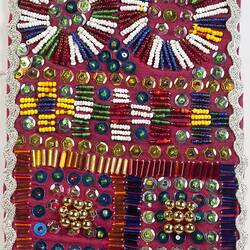Summary
Alternative Name: Fustane
White cotton dress which reflects the traditional style of the Dumre region in central Albania. It was made around 1900 and was purchased, as part of a traditional costume, in 1997 by Mustafe and Sanije Memishi in Kruja, Albania during their first pilgrimage back to their homeland after migrating to Australia in the 1960s.
The costume was selected by daughters Esmine and Lirije who were drawn to its simple folkloric design. The Memishi daughters wore the costume to the Albanian Festival at Footscray Park up until the mid 2000s.
This is a special occasion costume worn at weddings, engagements and sacred cultural ceremonies. It is a simple style of dress, enhanced through a variety of decorative elements including textures, weaves, and colours. The costume would traditionally have been further adorned with decorative jewellery, usually in the form of a coin necklace. This jewellery would have been presented to the wearer on special occasions and placed in an embroidered wool woven tote, made to hold gifts and items when attending functions in distant villages. The dress apron and scarf enable the wearer to continue their domestic duties while remaining respectably attired, according to the requirements of Albanian society of the early 1900s.
Physical Description
Full length white cotton undershirt with vertical striping. The dress is gathered under the armpits, with long wide sleeves with embroidered detailing in red thread at the cuff and partially up the sleeves. There is red stitching around the collar and along the front opening at the neck.
Significance
This costume represents an active effort by one family to re-connect with and preserve their cultural traditions, by transporting the costume to Australia where it could act as a tangible reminder of their cultural heritage and actively used in cultural celebrations. The costume also represents the vanishing needlecraft skills of Albanian women, symbolising the important role women have played in the traditions of artistic production.
More Information
-
Collecting Areas
-
Acquisition Information
Donation from Sanije & Mustafe Memishi, 30 Sep 2008
-
Place & Date Made
-
Other Association (See Comments)
Sanije & Mustafe Memishi, Kruja, Albania, 1997
Purchasers of Item -
User
Miss Lirije Memishi, Footscray, Greater Melbourne, Victoria, Australia, 1997-2005
-
User
Miss Esmine Memishi, Footscray, Greater Melbourne, Victoria, Australia, 1997-2005
-
Classification
-
Category
-
Discipline
-
Type of item
-
Overall Dimensions
1400 mm (Length), 1360 mm (Width), 35 mm (Depth)
-
References
Kurbet. The continuing journey of Albanians in Victoria, Immigration Museum Community Gallery room brochure, 2007-2008
-
Keywords
Albanian Communities, Albanian Immigration, Brought Goods, Cultural Maintenance, Cultural Traditions, Immigration, Muslims in Australia, National Costumes


